The Department of Environment, which comes under the Ministry of Forestry, Fisheries and Sustainable Development today held a media workshop in the village of Bermudian Landing. They want to encourage the press to feature the educational aspects of environmental protection on the news regularly.
And that started in the conference room of the Community Baboon Sanctuary in Bermudian Landing. Here's what the organizers told us:
Deidra Haylock
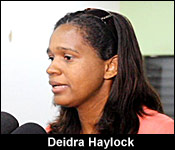 "Like it or not the media is a catalyst for change. The media is a vehicle for information, for knowledge and knowledge empowers change and so to get citizens informed, to change policies, to change behaviors, the media has to be involved and so it was a productive direction that the Department of Environment wanted to achieve and so I had recommended that they bring together at least the main departments within the Ministry of Forestry, Fisheries and Sustainable Development, so that they could talk to the media about who they are, what they do, how their legislation covers them, what legislations fall under their purview and where there is avenue for relationship."
"Like it or not the media is a catalyst for change. The media is a vehicle for information, for knowledge and knowledge empowers change and so to get citizens informed, to change policies, to change behaviors, the media has to be involved and so it was a productive direction that the Department of Environment wanted to achieve and so I had recommended that they bring together at least the main departments within the Ministry of Forestry, Fisheries and Sustainable Development, so that they could talk to the media about who they are, what they do, how their legislation covers them, what legislations fall under their purview and where there is avenue for relationship."
Edgar Eck. Deputy Chief Environmental Officer - DOE
 "We have very weak partnership with the media, not only us but the other way as well the media having a weak partnership with the different government entities. What we are trying to do is to strengthen that so that we could share information and provide you with the information necessary that you could make up the story that deals with the environment."
"We have very weak partnership with the media, not only us but the other way as well the media having a weak partnership with the different government entities. What we are trying to do is to strengthen that so that we could share information and provide you with the information necessary that you could make up the story that deals with the environment."
"The mandate of the Department of the Environment is very broad. Basically, we are looking at pollution prevention and that deals with basically 4 types of pollution; land, water, air and noise pollution as well. The challenges that we face are basically the same throughout the government service; that dealing with technical expertise, that dealing with financial resources allocated for the activities that we have to carry on. Technical, financial and human resources; I think those are the 3 main constraints that we have. As you are aware the Department of the Environment only has a headquarter office and the number of persons that we have working in there to carry out our mandate is only about 20 persons."
Felicia Cruz, Fisheries Officer - Fisheries Dept.
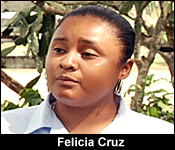 "The increase in enforcement and awareness, those 2 together are something that I've seen and observe to be increasing over the period of years that I've been back at the department. It's something that we try to engage the communities, the fisher folks, other stakeholders, consumers. We try to engage all of them so that they can be knowledgeable of our fisheries regulations, our laws, our close season and all of these information."
"The increase in enforcement and awareness, those 2 together are something that I've seen and observe to be increasing over the period of years that I've been back at the department. It's something that we try to engage the communities, the fisher folks, other stakeholders, consumers. We try to engage all of them so that they can be knowledgeable of our fisheries regulations, our laws, our close season and all of these information."
Deidra Haylock
"One of the things I've critically said to the Department of the Environment and I've said here today is that working with the media is a relationship. It's not a one sided thing. So, they can't only be willing to come to the media when there is good news. They have to be able to speak with the media when it may seem as bad news too, or they may be a conflict or a controversy."
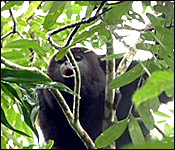 And while we were there, the management of the Community Baboon Sanctuary allowed us to go on a tour to see the conservation work they've been maintaining, as well as to experience the treat of seeing the baboons in their natural habitat, something that the tourists get to enjoy more than the locals. Here's what they told us:
And while we were there, the management of the Community Baboon Sanctuary allowed us to go on a tour to see the conservation work they've been maintaining, as well as to experience the treat of seeing the baboons in their natural habitat, something that the tourists get to enjoy more than the locals. Here's what they told us:
Conway Young, Volunteer Admin. - Baboon Sanctuary
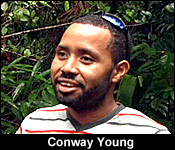 "The Community Baboon Sanctuary was one of the first in the world in terms of how it's structured. There are 7 villages that are literally inside the protected area and it's a voluntary private protected area, meaning that the 240 land owners signed a voluntary pledge saying that they are going to abide by certain rules and these rules basically consists leaf trees, leave a corridor connecting to different patches of forest and we ask them to leave 66 feet of forest alongside the river which is a law in government book. The Community Baboon Sanctuary was officially opened on the 23rd February, 1985. We started with 4 square miles, just around 800 black Howler Monkeys. In 1986, we expanded to 20 sq. miles making it a total population of 1200 Howler Monkeys. Our last population chart that we did on satellite imagery, based on forest cover and based on the baseline data that we had of how much monkeys are in a family and how much forest they need - the population chart is telling us that we have between 4,000-5,000 black Howler Monkeys. So we've increase significantly over the years."
"The Community Baboon Sanctuary was one of the first in the world in terms of how it's structured. There are 7 villages that are literally inside the protected area and it's a voluntary private protected area, meaning that the 240 land owners signed a voluntary pledge saying that they are going to abide by certain rules and these rules basically consists leaf trees, leave a corridor connecting to different patches of forest and we ask them to leave 66 feet of forest alongside the river which is a law in government book. The Community Baboon Sanctuary was officially opened on the 23rd February, 1985. We started with 4 square miles, just around 800 black Howler Monkeys. In 1986, we expanded to 20 sq. miles making it a total population of 1200 Howler Monkeys. Our last population chart that we did on satellite imagery, based on forest cover and based on the baseline data that we had of how much monkeys are in a family and how much forest they need - the population chart is telling us that we have between 4,000-5,000 black Howler Monkeys. So we've increase significantly over the years."
"In the inception the Community Baboon Sanctuary was managed by the Audubon Society and a couple years later it was solely managed by a group of men within the community by the community. But in 1998, a women' conservation group was formed and they took over the management of the Community Baboon Sanctuary and they are still presently managing the sanctuary."
Robert Pantin Jr., Tour Guide - 24 years' Experience
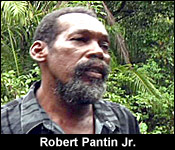 "These monkeys are a little bit use to people. It because we have about 25,000 - 30,000 visitors for the year. Due to the fact they have a limited time frame and the interaction with the monkeys are close as you could see. When tourists get a chance to being so close to these monkeys, they feel so excited about it, not knowing that we could interact with monkeys that close. It took us years to do this. It's not an overnight thing."
"These monkeys are a little bit use to people. It because we have about 25,000 - 30,000 visitors for the year. Due to the fact they have a limited time frame and the interaction with the monkeys are close as you could see. When tourists get a chance to being so close to these monkeys, they feel so excited about it, not knowing that we could interact with monkeys that close. It took us years to do this. It's not an overnight thing."
The Community Baboon Sanctuary has been managed by the Women's Conservation Group, since 1998.



